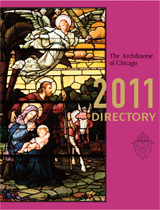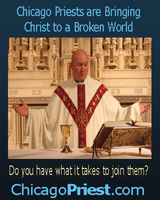‘Santa Claus’ tries to limit Christmas commercialism

A regular feature of The Catholic New World, The InterVIEW is an in-depth conversation with a person whose words, actions or ideas affect today's Catholic. It may be affirming of faith or confrontational. But it will always be stimulating.
Charles Hitzeman is not Santa Claus. At least not the real one. But for the past several years, he has donned the red suit at St. Louise de Marillac Parish’s annual “Breakfast with Santa,” serving as one Santa’s innumerable holiday helpers. He said having children of his own — one is almost 3, and one is less than a year old — has heightened his appreciation of the role of Santa Claus. Before getting ready to stand in for the big guy this year, he spoke by telephone with Catholic New World assistant editor Michelle Martin.
Catholic New World: Do you try to make a connection between being Santa and the religious meaning of Christmas, being that you are at a parish event?
Hitzeman: I’d like to say yes, but at that point, it’s so commercial. It’s hard tying the religion to it. The kids are just asking for what they want.
Catholic New World: What’s the thing most kids ask for?
Hitzeman: Unfortunately, more often than not, it’s video games. For both girls and boys. But I would never, ever tell them they are getting a video game for Christmas.
Catholic New World: Do you ever say what they might get for Christmas?
Hitzeman: That’s what nice about doing it at my own parish. Sometimes, if I kind of know the family, and what the kid is asking for is something reasonable, and the parents are standing there smiling and nodding, I can say, yes, if you are a good boy or girl I might bring this for Christmas. That’s always nice, because then the parents are happy and the kids are happy.
Catholic New World: Do you ever have kids who are afraid of Santa?
Hitzeman: I do — and kids of all ages. A lot of them are 3- and 4-year-old kids who are scared of Santa. They don’t want to come up. You just let them come to you, and sometimes they warm up to the idea.
The worst thing you can do is reach out toward them, like try to shake their hand or something.
Catholic New World: How did you start doing this?
Hitzeman: My wife was actually a preschool teacher at the school, and my mother-in-law made me a Winnie the Pooh costume for Halloween – I filled it out nicely – and the kids really liked it. So they asked me to be Santa.
Catholic New World: Have the kids recognized you?
Hitzeman: The older kids do, but they know it’s not really Santa anyway. I don’t think so with the younger ones. I had a problem with my 2-year-old last year. She didn’t recognize me with the costume until I talked. Then she recognized my voice and it confused her and she started to cry. We brought her to see a different Santa and she was fine.
Catholic New World: Why do you like doing this?
Hitzeman: It’s seeing the boys’ and girls’ eyes light up and seeing them smile. I’m kind of in the helping or giving public service business anyway — I’m a funeral director — so I like to do what I can for people. But you definitely have to like kids to do it. And it’s fun seeing not only the kids but the parents.
Catholic New World: What do you tell the kids before they leave?
Hitzeman: A lot of the time, the ones who are asking for video games, I’ll tell them I like milk and cookies — and I like it when the cookies are fresh-baked, to inspire that parent-child interaction.
It’s so easy to get wrapped up in all the commercial aspects of Santa, I’m always looking for ways to remind them what’s more important.
The real St. Nick
“Santa Claus,” the ubiquitous man in the red suit, bears little resemblance to his namesake, the fourthcentury St. Nicholas, Bishop of Myrna. During his lifetime, he was apparently respected and venerated for his piety, was imprisoned for his faith and was present at the Council of Nicea. When he died, he was buried in his cathedral.
That much is known. Other legends grew up starting around the time of St. Methodius, who wrote about St. Nicholas nearly 500 years after his death.
That is the period when the first tales of his generosity appeared, including the story of how he anonymously gave dowry money to three daughters of a man who had lost his fortune — throwing the money through an open window, into the stockings drying on the bedposts, according to the story — enabling the girls to marry.
He is known as the patron of sailors and children, and was revered throughout eastern and western Europe.
The “jolly old St. Nick” of American custom did not arrive until the 19th century, by way of the Dutch settlers of New York and “Sinter Klaas,” who was celebrated on his feast day of Dec. 6, even after the Reformation.
Washington Irving, writing under the name Diedrich Knickerbocker, told of St. Nick arriving on horseback on Dec. 6 in his “History of New York,” published in 1809. Fourteen years later, Clement Moore moved the date of his visit to Christmas Eve, gave him reindeer (and named all of them) along with a jolly laugh and belly that shook “like a bowl full of jelly”) in “A Visit from St. Nicholas” in 1823.




